An Analysis of Leadership and Management at Za Za Bazaar Restaurant
VerifiedAdded on 2022/11/24
|10
|3591
|339
Report
AI Summary
This report provides a comprehensive analysis of leadership and management principles within the context of Za Za Bazaar, a restaurant chain. It begins by introducing the interlinked nature of leadership and management, emphasizing the importance of leadership in achieving organizational objectives. The report then delves into classical management theories, including bureaucratic, scientific, behavioral, and human relations theories, examining their application within the service industry of Za Za Bazaar. It further explores the roles of leaders, different leadership styles such as authoritarian, participative, delegative, and transformational leadership, and reviews the strengths and weaknesses of various management and leadership approaches. The report also investigates internal and external factors that influence management styles, such as leadership, employees, mission statements, and competitive forces. The analysis extends to current and future management and leadership skills, concluding with a discussion of the skills required for the organization's future success. The report aims to provide insights into effective management practices for the restaurant business.
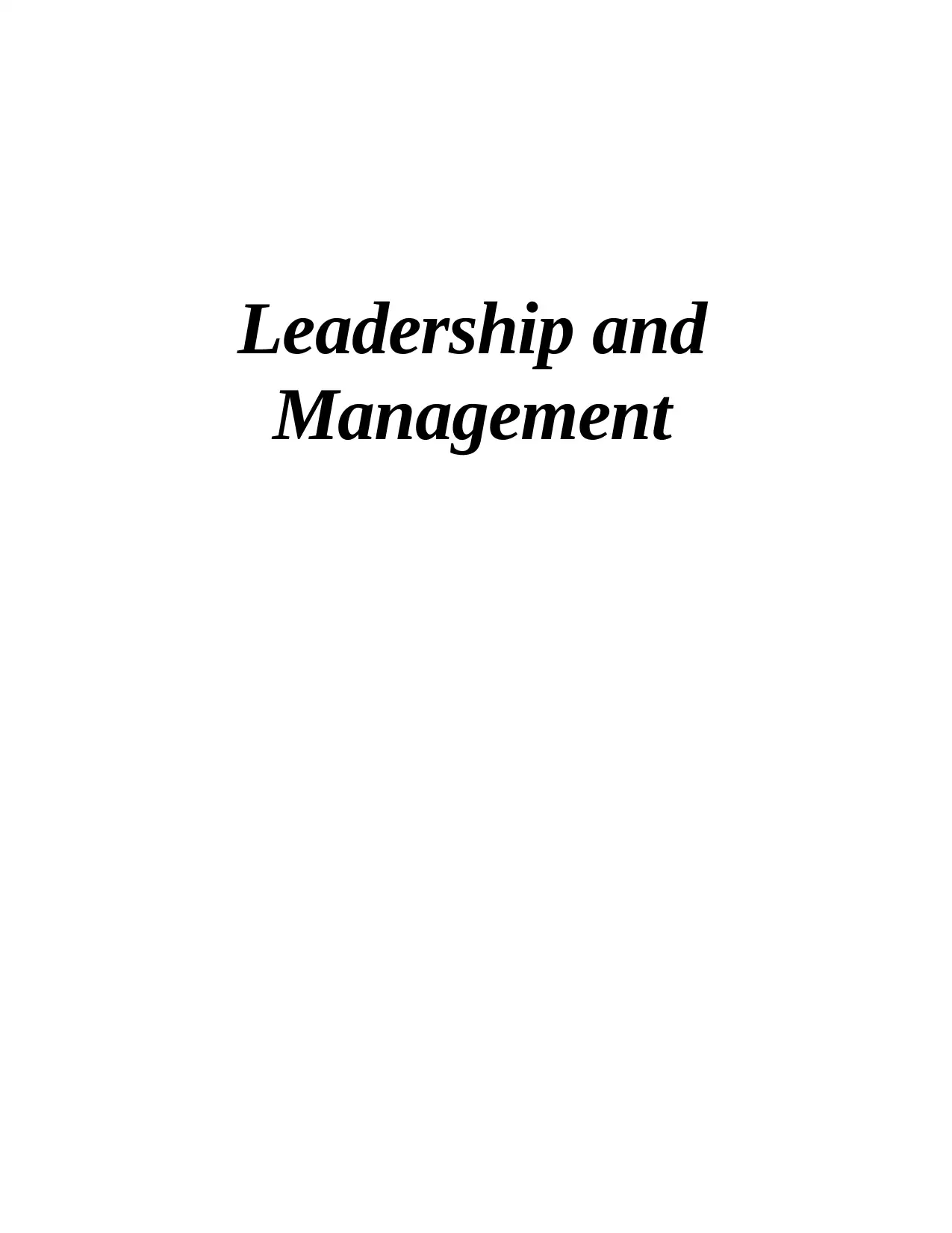
Leadership and
Management
Management
Paraphrase This Document
Need a fresh take? Get an instant paraphrase of this document with our AI Paraphraser
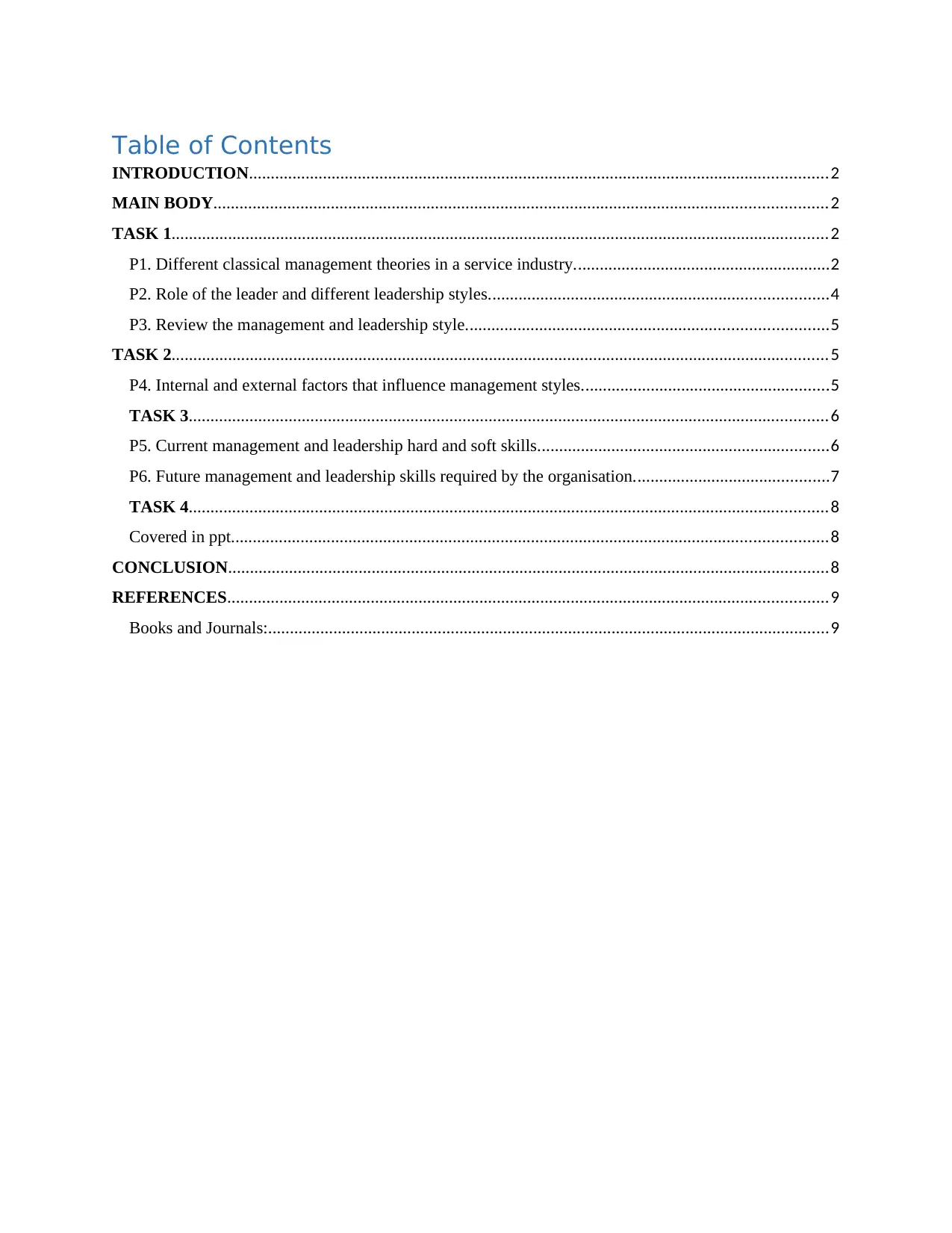
Table of Contents
INTRODUCTION.....................................................................................................................................2
MAIN BODY.............................................................................................................................................2
TASK 1.......................................................................................................................................................2
P1. Different classical management theories in a service industry...........................................................2
P2. Role of the leader and different leadership styles..............................................................................4
P3. Review the management and leadership style...................................................................................5
TASK 2.......................................................................................................................................................5
P4. Internal and external factors that influence management styles.........................................................5
TASK 3...................................................................................................................................................6
P5. Current management and leadership hard and soft skills...................................................................6
P6. Future management and leadership skills required by the organisation.............................................7
TASK 4...................................................................................................................................................8
Covered in ppt.........................................................................................................................................8
CONCLUSION..........................................................................................................................................8
REFERENCES..........................................................................................................................................9
Books and Journals:.................................................................................................................................9
INTRODUCTION.....................................................................................................................................2
MAIN BODY.............................................................................................................................................2
TASK 1.......................................................................................................................................................2
P1. Different classical management theories in a service industry...........................................................2
P2. Role of the leader and different leadership styles..............................................................................4
P3. Review the management and leadership style...................................................................................5
TASK 2.......................................................................................................................................................5
P4. Internal and external factors that influence management styles.........................................................5
TASK 3...................................................................................................................................................6
P5. Current management and leadership hard and soft skills...................................................................6
P6. Future management and leadership skills required by the organisation.............................................7
TASK 4...................................................................................................................................................8
Covered in ppt.........................................................................................................................................8
CONCLUSION..........................................................................................................................................8
REFERENCES..........................................................................................................................................9
Books and Journals:.................................................................................................................................9
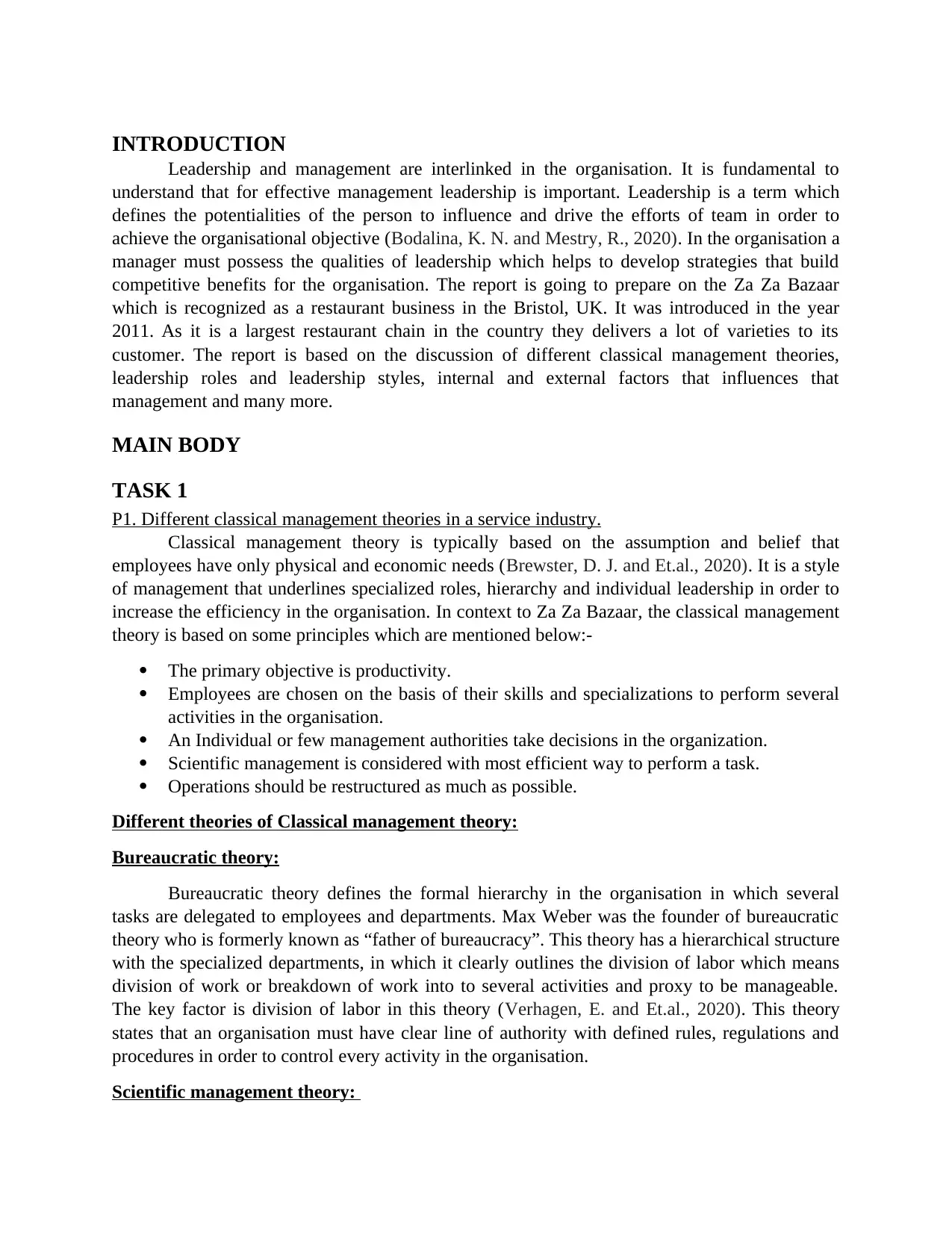
INTRODUCTION
Leadership and management are interlinked in the organisation. It is fundamental to
understand that for effective management leadership is important. Leadership is a term which
defines the potentialities of the person to influence and drive the efforts of team in order to
achieve the organisational objective (Bodalina, K. N. and Mestry, R., 2020). In the organisation a
manager must possess the qualities of leadership which helps to develop strategies that build
competitive benefits for the organisation. The report is going to prepare on the Za Za Bazaar
which is recognized as a restaurant business in the Bristol, UK. It was introduced in the year
2011. As it is a largest restaurant chain in the country they delivers a lot of varieties to its
customer. The report is based on the discussion of different classical management theories,
leadership roles and leadership styles, internal and external factors that influences that
management and many more.
MAIN BODY
TASK 1
P1. Different classical management theories in a service industry.
Classical management theory is typically based on the assumption and belief that
employees have only physical and economic needs (Brewster, D. J. and Et.al., 2020). It is a style
of management that underlines specialized roles, hierarchy and individual leadership in order to
increase the efficiency in the organisation. In context to Za Za Bazaar, the classical management
theory is based on some principles which are mentioned below:-
The primary objective is productivity.
Employees are chosen on the basis of their skills and specializations to perform several
activities in the organisation.
An Individual or few management authorities take decisions in the organization.
Scientific management is considered with most efficient way to perform a task.
Operations should be restructured as much as possible.
Different theories of Classical management theory:
Bureaucratic theory:
Bureaucratic theory defines the formal hierarchy in the organisation in which several
tasks are delegated to employees and departments. Max Weber was the founder of bureaucratic
theory who is formerly known as “father of bureaucracy”. This theory has a hierarchical structure
with the specialized departments, in which it clearly outlines the division of labor which means
division of work or breakdown of work into to several activities and proxy to be manageable.
The key factor is division of labor in this theory (Verhagen, E. and Et.al., 2020). This theory
states that an organisation must have clear line of authority with defined rules, regulations and
procedures in order to control every activity in the organisation.
Scientific management theory:
Leadership and management are interlinked in the organisation. It is fundamental to
understand that for effective management leadership is important. Leadership is a term which
defines the potentialities of the person to influence and drive the efforts of team in order to
achieve the organisational objective (Bodalina, K. N. and Mestry, R., 2020). In the organisation a
manager must possess the qualities of leadership which helps to develop strategies that build
competitive benefits for the organisation. The report is going to prepare on the Za Za Bazaar
which is recognized as a restaurant business in the Bristol, UK. It was introduced in the year
2011. As it is a largest restaurant chain in the country they delivers a lot of varieties to its
customer. The report is based on the discussion of different classical management theories,
leadership roles and leadership styles, internal and external factors that influences that
management and many more.
MAIN BODY
TASK 1
P1. Different classical management theories in a service industry.
Classical management theory is typically based on the assumption and belief that
employees have only physical and economic needs (Brewster, D. J. and Et.al., 2020). It is a style
of management that underlines specialized roles, hierarchy and individual leadership in order to
increase the efficiency in the organisation. In context to Za Za Bazaar, the classical management
theory is based on some principles which are mentioned below:-
The primary objective is productivity.
Employees are chosen on the basis of their skills and specializations to perform several
activities in the organisation.
An Individual or few management authorities take decisions in the organization.
Scientific management is considered with most efficient way to perform a task.
Operations should be restructured as much as possible.
Different theories of Classical management theory:
Bureaucratic theory:
Bureaucratic theory defines the formal hierarchy in the organisation in which several
tasks are delegated to employees and departments. Max Weber was the founder of bureaucratic
theory who is formerly known as “father of bureaucracy”. This theory has a hierarchical structure
with the specialized departments, in which it clearly outlines the division of labor which means
division of work or breakdown of work into to several activities and proxy to be manageable.
The key factor is division of labor in this theory (Verhagen, E. and Et.al., 2020). This theory
states that an organisation must have clear line of authority with defined rules, regulations and
procedures in order to control every activity in the organisation.
Scientific management theory:
⊘ This is a preview!⊘
Do you want full access?
Subscribe today to unlock all pages.

Trusted by 1+ million students worldwide

Federick W. Taylor was the founder of scientific theory of management in which it is
comprised with several scientific methods which helps to increase the productivity and enhance
the production process in the organisation (Thien, L. M. and Chan, S. Y., 2020). It is emphasized
that managers just adopted a proper production system that will be helpful in achieving the
economic efficiencies. This theory of management specifies six roles which are mentioned
below:
Planning
Forecasting
Coordinating
Commanding
Controlling
Organising
Behavioral theory:
Behavioral theory of management is a concept in which understanding the motivation of
employee which includes needs, expectations, interest, and group dynamics. This theory is also
recognized as social science movement in which its tactic to the organisation should be the best
interest for employees and company both (Peters, S. C. and Hopkins, K., 2019). This suggest that
there is no separation between employer and human being. In order to comprehend the success
within an organisation it is important to understand the needs and wants of employees in the
organisation.
Human relations theory:
Human relations theory of management emphasize on the satisfaction of employees, means
of influencing employees productivity and informal workplace organization. This theory
emphasis on the understanding which involved with employee skills and theories in order to get
success with the employees. It is a belief of this theory that employees is a supportive part who
facilitates growth and development for the organisation. If they feel motivated and get a special
attention in return they are willing to do they work with significance and it becomes more
productive which results high quality work for the organisation. In human relations theory, there
are six points in which problems can be solved in the organizations:
Acceptance of other opinions.
Listening each other thoughts and opinions.
Coordination must be achieved in the early stages.
Coordination is a continuous process.
Integration of new points in chase of a common objective.
Coordination must have reciprocal understanding.
It has been identified that bureaucratic theory is surrounded to control over something with
the use of authorities and powers. In context to Za Za organisation, this concept helps to initiate
the growth and development of authorities in the organisation while on the other side scientific
comprised with several scientific methods which helps to increase the productivity and enhance
the production process in the organisation (Thien, L. M. and Chan, S. Y., 2020). It is emphasized
that managers just adopted a proper production system that will be helpful in achieving the
economic efficiencies. This theory of management specifies six roles which are mentioned
below:
Planning
Forecasting
Coordinating
Commanding
Controlling
Organising
Behavioral theory:
Behavioral theory of management is a concept in which understanding the motivation of
employee which includes needs, expectations, interest, and group dynamics. This theory is also
recognized as social science movement in which its tactic to the organisation should be the best
interest for employees and company both (Peters, S. C. and Hopkins, K., 2019). This suggest that
there is no separation between employer and human being. In order to comprehend the success
within an organisation it is important to understand the needs and wants of employees in the
organisation.
Human relations theory:
Human relations theory of management emphasize on the satisfaction of employees, means
of influencing employees productivity and informal workplace organization. This theory
emphasis on the understanding which involved with employee skills and theories in order to get
success with the employees. It is a belief of this theory that employees is a supportive part who
facilitates growth and development for the organisation. If they feel motivated and get a special
attention in return they are willing to do they work with significance and it becomes more
productive which results high quality work for the organisation. In human relations theory, there
are six points in which problems can be solved in the organizations:
Acceptance of other opinions.
Listening each other thoughts and opinions.
Coordination must be achieved in the early stages.
Coordination is a continuous process.
Integration of new points in chase of a common objective.
Coordination must have reciprocal understanding.
It has been identified that bureaucratic theory is surrounded to control over something with
the use of authorities and powers. In context to Za Za organisation, this concept helps to initiate
the growth and development of authorities in the organisation while on the other side scientific
Paraphrase This Document
Need a fresh take? Get an instant paraphrase of this document with our AI Paraphraser
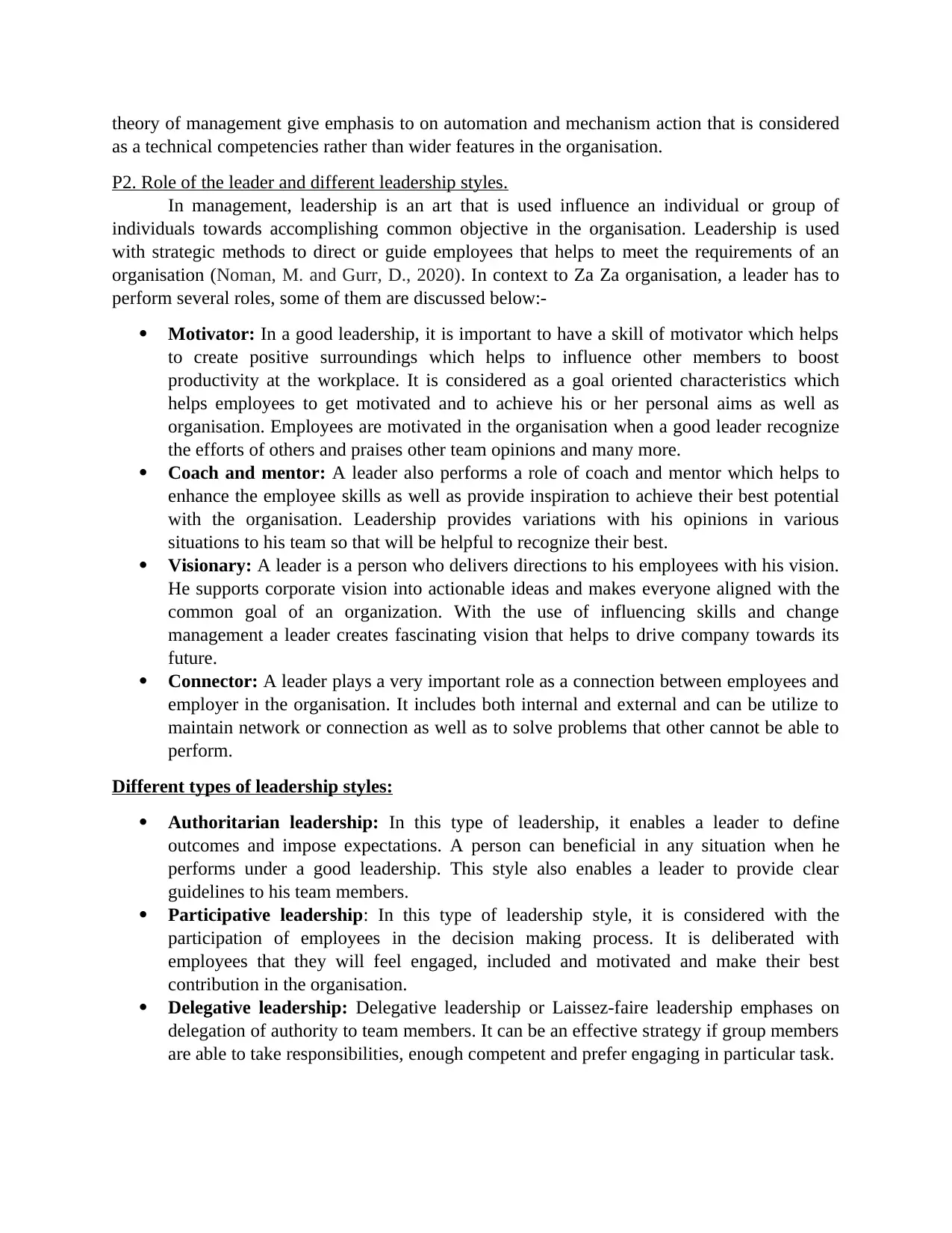
theory of management give emphasis to on automation and mechanism action that is considered
as a technical competencies rather than wider features in the organisation.
P2. Role of the leader and different leadership styles.
In management, leadership is an art that is used influence an individual or group of
individuals towards accomplishing common objective in the organisation. Leadership is used
with strategic methods to direct or guide employees that helps to meet the requirements of an
organisation (Noman, M. and Gurr, D., 2020). In context to Za Za organisation, a leader has to
perform several roles, some of them are discussed below:-
Motivator: In a good leadership, it is important to have a skill of motivator which helps
to create positive surroundings which helps to influence other members to boost
productivity at the workplace. It is considered as a goal oriented characteristics which
helps employees to get motivated and to achieve his or her personal aims as well as
organisation. Employees are motivated in the organisation when a good leader recognize
the efforts of others and praises other team opinions and many more.
Coach and mentor: A leader also performs a role of coach and mentor which helps to
enhance the employee skills as well as provide inspiration to achieve their best potential
with the organisation. Leadership provides variations with his opinions in various
situations to his team so that will be helpful to recognize their best.
Visionary: A leader is a person who delivers directions to his employees with his vision.
He supports corporate vision into actionable ideas and makes everyone aligned with the
common goal of an organization. With the use of influencing skills and change
management a leader creates fascinating vision that helps to drive company towards its
future.
Connector: A leader plays a very important role as a connection between employees and
employer in the organisation. It includes both internal and external and can be utilize to
maintain network or connection as well as to solve problems that other cannot be able to
perform.
Different types of leadership styles:
Authoritarian leadership: In this type of leadership, it enables a leader to define
outcomes and impose expectations. A person can beneficial in any situation when he
performs under a good leadership. This style also enables a leader to provide clear
guidelines to his team members.
Participative leadership: In this type of leadership style, it is considered with the
participation of employees in the decision making process. It is deliberated with
employees that they will feel engaged, included and motivated and make their best
contribution in the organisation.
Delegative leadership: Delegative leadership or Laissez-faire leadership emphases on
delegation of authority to team members. It can be an effective strategy if group members
are able to take responsibilities, enough competent and prefer engaging in particular task.
as a technical competencies rather than wider features in the organisation.
P2. Role of the leader and different leadership styles.
In management, leadership is an art that is used influence an individual or group of
individuals towards accomplishing common objective in the organisation. Leadership is used
with strategic methods to direct or guide employees that helps to meet the requirements of an
organisation (Noman, M. and Gurr, D., 2020). In context to Za Za organisation, a leader has to
perform several roles, some of them are discussed below:-
Motivator: In a good leadership, it is important to have a skill of motivator which helps
to create positive surroundings which helps to influence other members to boost
productivity at the workplace. It is considered as a goal oriented characteristics which
helps employees to get motivated and to achieve his or her personal aims as well as
organisation. Employees are motivated in the organisation when a good leader recognize
the efforts of others and praises other team opinions and many more.
Coach and mentor: A leader also performs a role of coach and mentor which helps to
enhance the employee skills as well as provide inspiration to achieve their best potential
with the organisation. Leadership provides variations with his opinions in various
situations to his team so that will be helpful to recognize their best.
Visionary: A leader is a person who delivers directions to his employees with his vision.
He supports corporate vision into actionable ideas and makes everyone aligned with the
common goal of an organization. With the use of influencing skills and change
management a leader creates fascinating vision that helps to drive company towards its
future.
Connector: A leader plays a very important role as a connection between employees and
employer in the organisation. It includes both internal and external and can be utilize to
maintain network or connection as well as to solve problems that other cannot be able to
perform.
Different types of leadership styles:
Authoritarian leadership: In this type of leadership, it enables a leader to define
outcomes and impose expectations. A person can beneficial in any situation when he
performs under a good leadership. This style also enables a leader to provide clear
guidelines to his team members.
Participative leadership: In this type of leadership style, it is considered with the
participation of employees in the decision making process. It is deliberated with
employees that they will feel engaged, included and motivated and make their best
contribution in the organisation.
Delegative leadership: Delegative leadership or Laissez-faire leadership emphases on
delegation of authority to team members. It can be an effective strategy if group members
are able to take responsibilities, enough competent and prefer engaging in particular task.
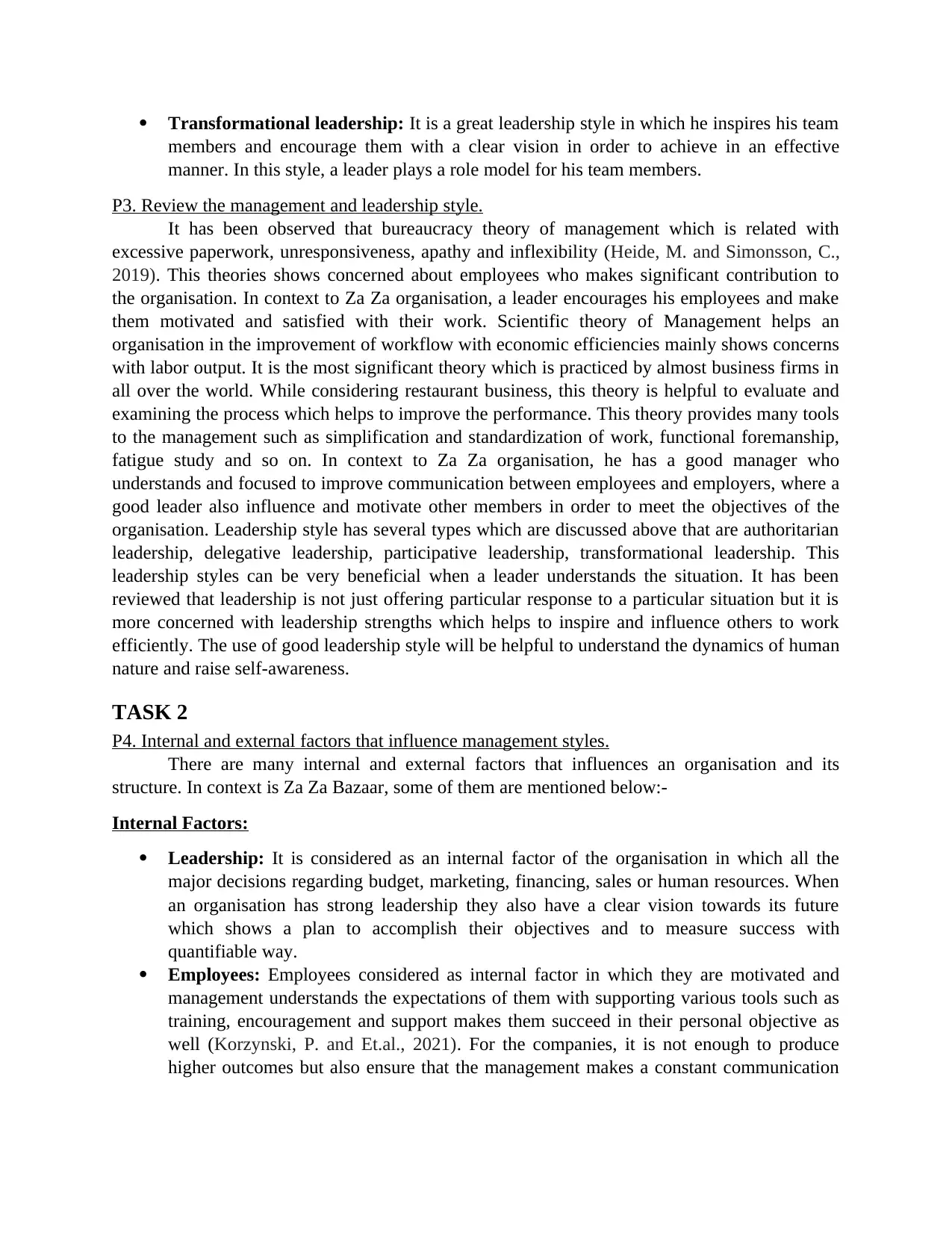
Transformational leadership: It is a great leadership style in which he inspires his team
members and encourage them with a clear vision in order to achieve in an effective
manner. In this style, a leader plays a role model for his team members.
P3. Review the management and leadership style.
It has been observed that bureaucracy theory of management which is related with
excessive paperwork, unresponsiveness, apathy and inflexibility (Heide, M. and Simonsson, C.,
2019). This theories shows concerned about employees who makes significant contribution to
the organisation. In context to Za Za organisation, a leader encourages his employees and make
them motivated and satisfied with their work. Scientific theory of Management helps an
organisation in the improvement of workflow with economic efficiencies mainly shows concerns
with labor output. It is the most significant theory which is practiced by almost business firms in
all over the world. While considering restaurant business, this theory is helpful to evaluate and
examining the process which helps to improve the performance. This theory provides many tools
to the management such as simplification and standardization of work, functional foremanship,
fatigue study and so on. In context to Za Za organisation, he has a good manager who
understands and focused to improve communication between employees and employers, where a
good leader also influence and motivate other members in order to meet the objectives of the
organisation. Leadership style has several types which are discussed above that are authoritarian
leadership, delegative leadership, participative leadership, transformational leadership. This
leadership styles can be very beneficial when a leader understands the situation. It has been
reviewed that leadership is not just offering particular response to a particular situation but it is
more concerned with leadership strengths which helps to inspire and influence others to work
efficiently. The use of good leadership style will be helpful to understand the dynamics of human
nature and raise self-awareness.
TASK 2
P4. Internal and external factors that influence management styles.
There are many internal and external factors that influences an organisation and its
structure. In context is Za Za Bazaar, some of them are mentioned below:-
Internal Factors:
Leadership: It is considered as an internal factor of the organisation in which all the
major decisions regarding budget, marketing, financing, sales or human resources. When
an organisation has strong leadership they also have a clear vision towards its future
which shows a plan to accomplish their objectives and to measure success with
quantifiable way.
Employees: Employees considered as internal factor in which they are motivated and
management understands the expectations of them with supporting various tools such as
training, encouragement and support makes them succeed in their personal objective as
well (Korzynski, P. and Et.al., 2021). For the companies, it is not enough to produce
higher outcomes but also ensure that the management makes a constant communication
members and encourage them with a clear vision in order to achieve in an effective
manner. In this style, a leader plays a role model for his team members.
P3. Review the management and leadership style.
It has been observed that bureaucracy theory of management which is related with
excessive paperwork, unresponsiveness, apathy and inflexibility (Heide, M. and Simonsson, C.,
2019). This theories shows concerned about employees who makes significant contribution to
the organisation. In context to Za Za organisation, a leader encourages his employees and make
them motivated and satisfied with their work. Scientific theory of Management helps an
organisation in the improvement of workflow with economic efficiencies mainly shows concerns
with labor output. It is the most significant theory which is practiced by almost business firms in
all over the world. While considering restaurant business, this theory is helpful to evaluate and
examining the process which helps to improve the performance. This theory provides many tools
to the management such as simplification and standardization of work, functional foremanship,
fatigue study and so on. In context to Za Za organisation, he has a good manager who
understands and focused to improve communication between employees and employers, where a
good leader also influence and motivate other members in order to meet the objectives of the
organisation. Leadership style has several types which are discussed above that are authoritarian
leadership, delegative leadership, participative leadership, transformational leadership. This
leadership styles can be very beneficial when a leader understands the situation. It has been
reviewed that leadership is not just offering particular response to a particular situation but it is
more concerned with leadership strengths which helps to inspire and influence others to work
efficiently. The use of good leadership style will be helpful to understand the dynamics of human
nature and raise self-awareness.
TASK 2
P4. Internal and external factors that influence management styles.
There are many internal and external factors that influences an organisation and its
structure. In context is Za Za Bazaar, some of them are mentioned below:-
Internal Factors:
Leadership: It is considered as an internal factor of the organisation in which all the
major decisions regarding budget, marketing, financing, sales or human resources. When
an organisation has strong leadership they also have a clear vision towards its future
which shows a plan to accomplish their objectives and to measure success with
quantifiable way.
Employees: Employees considered as internal factor in which they are motivated and
management understands the expectations of them with supporting various tools such as
training, encouragement and support makes them succeed in their personal objective as
well (Korzynski, P. and Et.al., 2021). For the companies, it is not enough to produce
higher outcomes but also ensure that the management makes a constant communication
⊘ This is a preview!⊘
Do you want full access?
Subscribe today to unlock all pages.

Trusted by 1+ million students worldwide
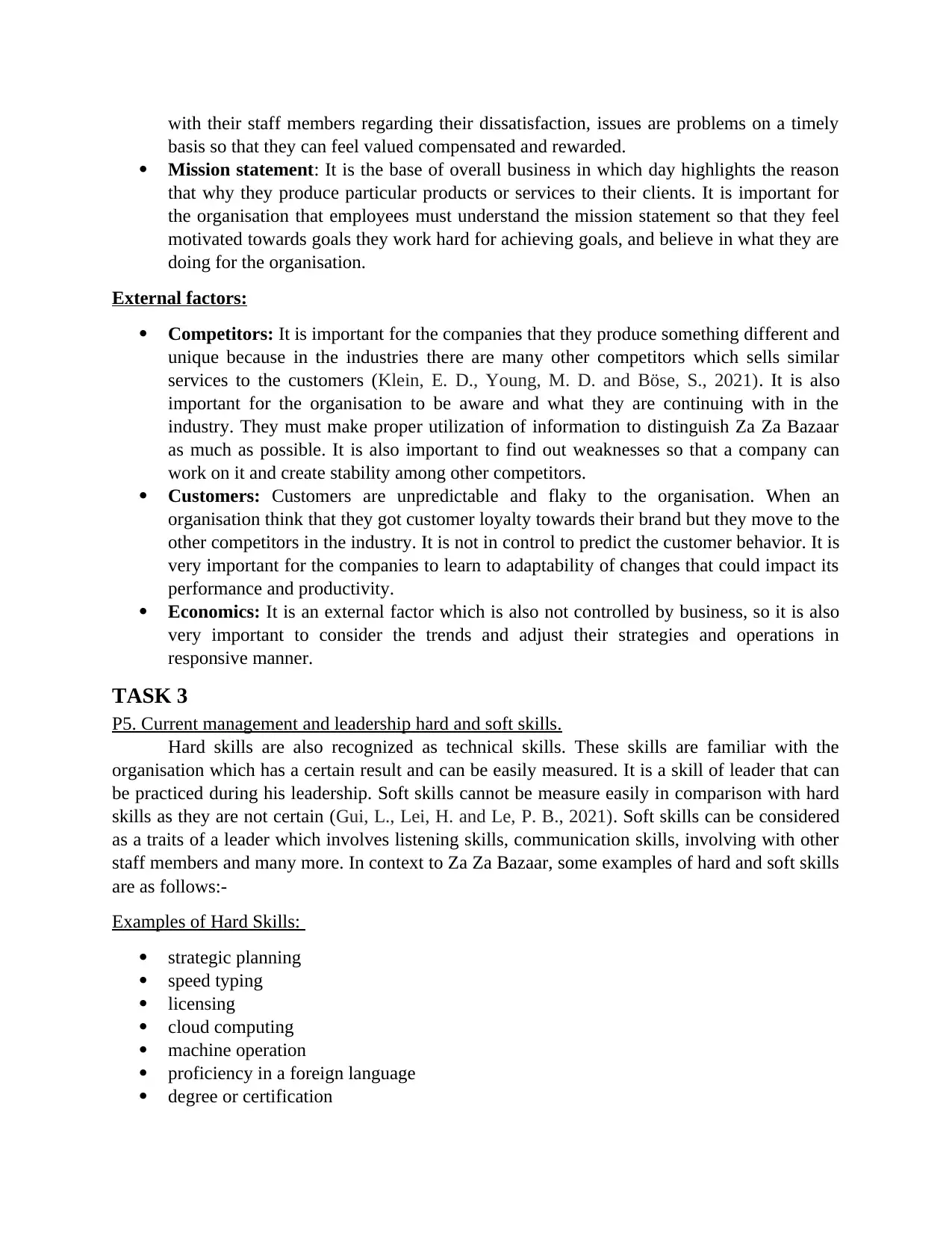
with their staff members regarding their dissatisfaction, issues are problems on a timely
basis so that they can feel valued compensated and rewarded.
Mission statement: It is the base of overall business in which day highlights the reason
that why they produce particular products or services to their clients. It is important for
the organisation that employees must understand the mission statement so that they feel
motivated towards goals they work hard for achieving goals, and believe in what they are
doing for the organisation.
External factors:
Competitors: It is important for the companies that they produce something different and
unique because in the industries there are many other competitors which sells similar
services to the customers (Klein, E. D., Young, M. D. and Böse, S., 2021). It is also
important for the organisation to be aware and what they are continuing with in the
industry. They must make proper utilization of information to distinguish Za Za Bazaar
as much as possible. It is also important to find out weaknesses so that a company can
work on it and create stability among other competitors.
Customers: Customers are unpredictable and flaky to the organisation. When an
organisation think that they got customer loyalty towards their brand but they move to the
other competitors in the industry. It is not in control to predict the customer behavior. It is
very important for the companies to learn to adaptability of changes that could impact its
performance and productivity.
Economics: It is an external factor which is also not controlled by business, so it is also
very important to consider the trends and adjust their strategies and operations in
responsive manner.
TASK 3
P5. Current management and leadership hard and soft skills.
Hard skills are also recognized as technical skills. These skills are familiar with the
organisation which has a certain result and can be easily measured. It is a skill of leader that can
be practiced during his leadership. Soft skills cannot be measure easily in comparison with hard
skills as they are not certain (Gui, L., Lei, H. and Le, P. B., 2021). Soft skills can be considered
as a traits of a leader which involves listening skills, communication skills, involving with other
staff members and many more. In context to Za Za Bazaar, some examples of hard and soft skills
are as follows:-
Examples of Hard Skills:
strategic planning
speed typing
licensing
cloud computing
machine operation
proficiency in a foreign language
degree or certification
basis so that they can feel valued compensated and rewarded.
Mission statement: It is the base of overall business in which day highlights the reason
that why they produce particular products or services to their clients. It is important for
the organisation that employees must understand the mission statement so that they feel
motivated towards goals they work hard for achieving goals, and believe in what they are
doing for the organisation.
External factors:
Competitors: It is important for the companies that they produce something different and
unique because in the industries there are many other competitors which sells similar
services to the customers (Klein, E. D., Young, M. D. and Böse, S., 2021). It is also
important for the organisation to be aware and what they are continuing with in the
industry. They must make proper utilization of information to distinguish Za Za Bazaar
as much as possible. It is also important to find out weaknesses so that a company can
work on it and create stability among other competitors.
Customers: Customers are unpredictable and flaky to the organisation. When an
organisation think that they got customer loyalty towards their brand but they move to the
other competitors in the industry. It is not in control to predict the customer behavior. It is
very important for the companies to learn to adaptability of changes that could impact its
performance and productivity.
Economics: It is an external factor which is also not controlled by business, so it is also
very important to consider the trends and adjust their strategies and operations in
responsive manner.
TASK 3
P5. Current management and leadership hard and soft skills.
Hard skills are also recognized as technical skills. These skills are familiar with the
organisation which has a certain result and can be easily measured. It is a skill of leader that can
be practiced during his leadership. Soft skills cannot be measure easily in comparison with hard
skills as they are not certain (Gui, L., Lei, H. and Le, P. B., 2021). Soft skills can be considered
as a traits of a leader which involves listening skills, communication skills, involving with other
staff members and many more. In context to Za Za Bazaar, some examples of hard and soft skills
are as follows:-
Examples of Hard Skills:
strategic planning
speed typing
licensing
cloud computing
machine operation
proficiency in a foreign language
degree or certification
Paraphrase This Document
Need a fresh take? Get an instant paraphrase of this document with our AI Paraphraser
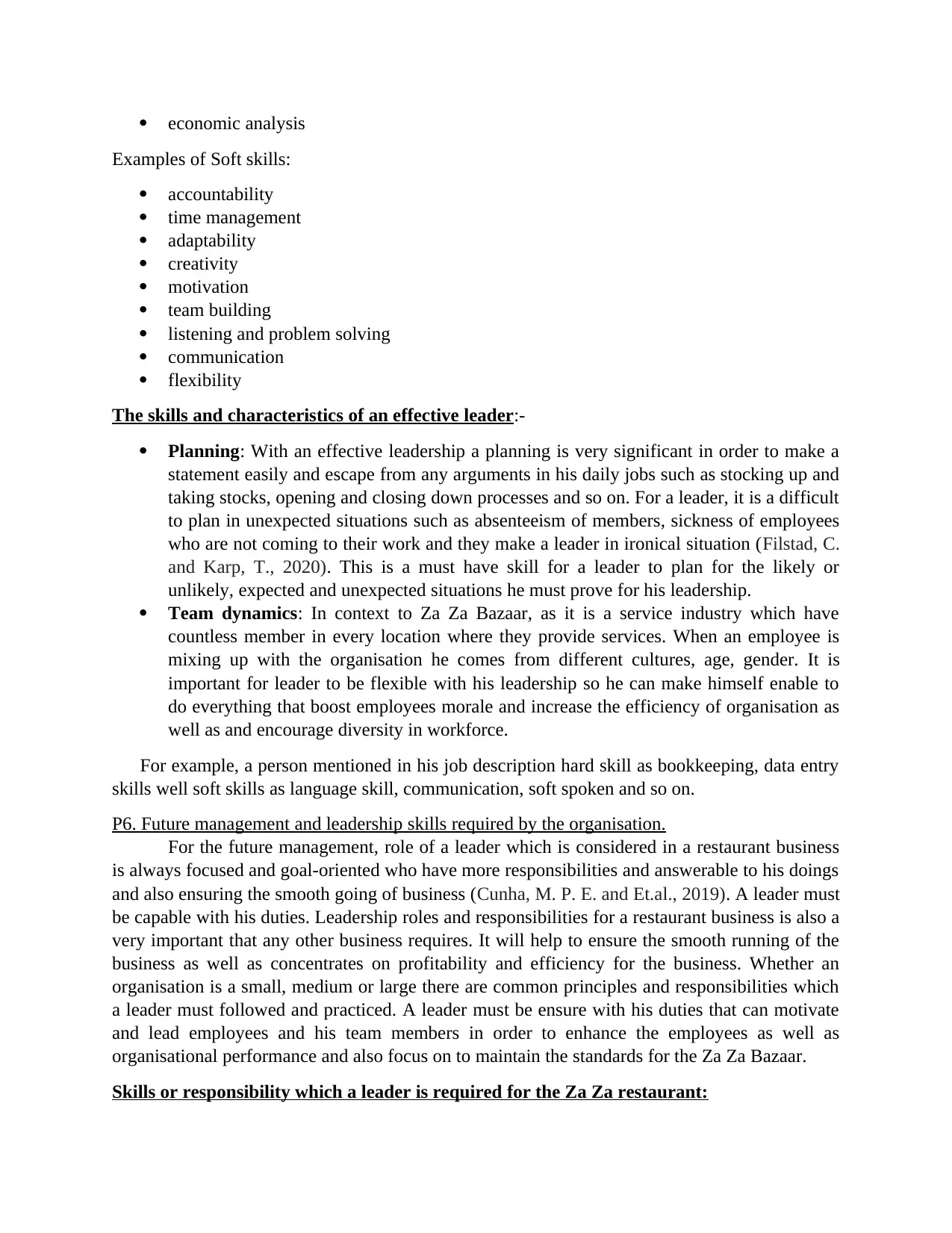
economic analysis
Examples of Soft skills:
accountability
time management
adaptability
creativity
motivation
team building
listening and problem solving
communication
flexibility
The skills and characteristics of an effective leader:-
Planning: With an effective leadership a planning is very significant in order to make a
statement easily and escape from any arguments in his daily jobs such as stocking up and
taking stocks, opening and closing down processes and so on. For a leader, it is a difficult
to plan in unexpected situations such as absenteeism of members, sickness of employees
who are not coming to their work and they make a leader in ironical situation (Filstad, C.
and Karp, T., 2020). This is a must have skill for a leader to plan for the likely or
unlikely, expected and unexpected situations he must prove for his leadership.
Team dynamics: In context to Za Za Bazaar, as it is a service industry which have
countless member in every location where they provide services. When an employee is
mixing up with the organisation he comes from different cultures, age, gender. It is
important for leader to be flexible with his leadership so he can make himself enable to
do everything that boost employees morale and increase the efficiency of organisation as
well as and encourage diversity in workforce.
For example, a person mentioned in his job description hard skill as bookkeeping, data entry
skills well soft skills as language skill, communication, soft spoken and so on.
P6. Future management and leadership skills required by the organisation.
For the future management, role of a leader which is considered in a restaurant business
is always focused and goal-oriented who have more responsibilities and answerable to his doings
and also ensuring the smooth going of business (Cunha, M. P. E. and Et.al., 2019). A leader must
be capable with his duties. Leadership roles and responsibilities for a restaurant business is also a
very important that any other business requires. It will help to ensure the smooth running of the
business as well as concentrates on profitability and efficiency for the business. Whether an
organisation is a small, medium or large there are common principles and responsibilities which
a leader must followed and practiced. A leader must be ensure with his duties that can motivate
and lead employees and his team members in order to enhance the employees as well as
organisational performance and also focus on to maintain the standards for the Za Za Bazaar.
Skills or responsibility which a leader is required for the Za Za restaurant:
Examples of Soft skills:
accountability
time management
adaptability
creativity
motivation
team building
listening and problem solving
communication
flexibility
The skills and characteristics of an effective leader:-
Planning: With an effective leadership a planning is very significant in order to make a
statement easily and escape from any arguments in his daily jobs such as stocking up and
taking stocks, opening and closing down processes and so on. For a leader, it is a difficult
to plan in unexpected situations such as absenteeism of members, sickness of employees
who are not coming to their work and they make a leader in ironical situation (Filstad, C.
and Karp, T., 2020). This is a must have skill for a leader to plan for the likely or
unlikely, expected and unexpected situations he must prove for his leadership.
Team dynamics: In context to Za Za Bazaar, as it is a service industry which have
countless member in every location where they provide services. When an employee is
mixing up with the organisation he comes from different cultures, age, gender. It is
important for leader to be flexible with his leadership so he can make himself enable to
do everything that boost employees morale and increase the efficiency of organisation as
well as and encourage diversity in workforce.
For example, a person mentioned in his job description hard skill as bookkeeping, data entry
skills well soft skills as language skill, communication, soft spoken and so on.
P6. Future management and leadership skills required by the organisation.
For the future management, role of a leader which is considered in a restaurant business
is always focused and goal-oriented who have more responsibilities and answerable to his doings
and also ensuring the smooth going of business (Cunha, M. P. E. and Et.al., 2019). A leader must
be capable with his duties. Leadership roles and responsibilities for a restaurant business is also a
very important that any other business requires. It will help to ensure the smooth running of the
business as well as concentrates on profitability and efficiency for the business. Whether an
organisation is a small, medium or large there are common principles and responsibilities which
a leader must followed and practiced. A leader must be ensure with his duties that can motivate
and lead employees and his team members in order to enhance the employees as well as
organisational performance and also focus on to maintain the standards for the Za Za Bazaar.
Skills or responsibility which a leader is required for the Za Za restaurant:
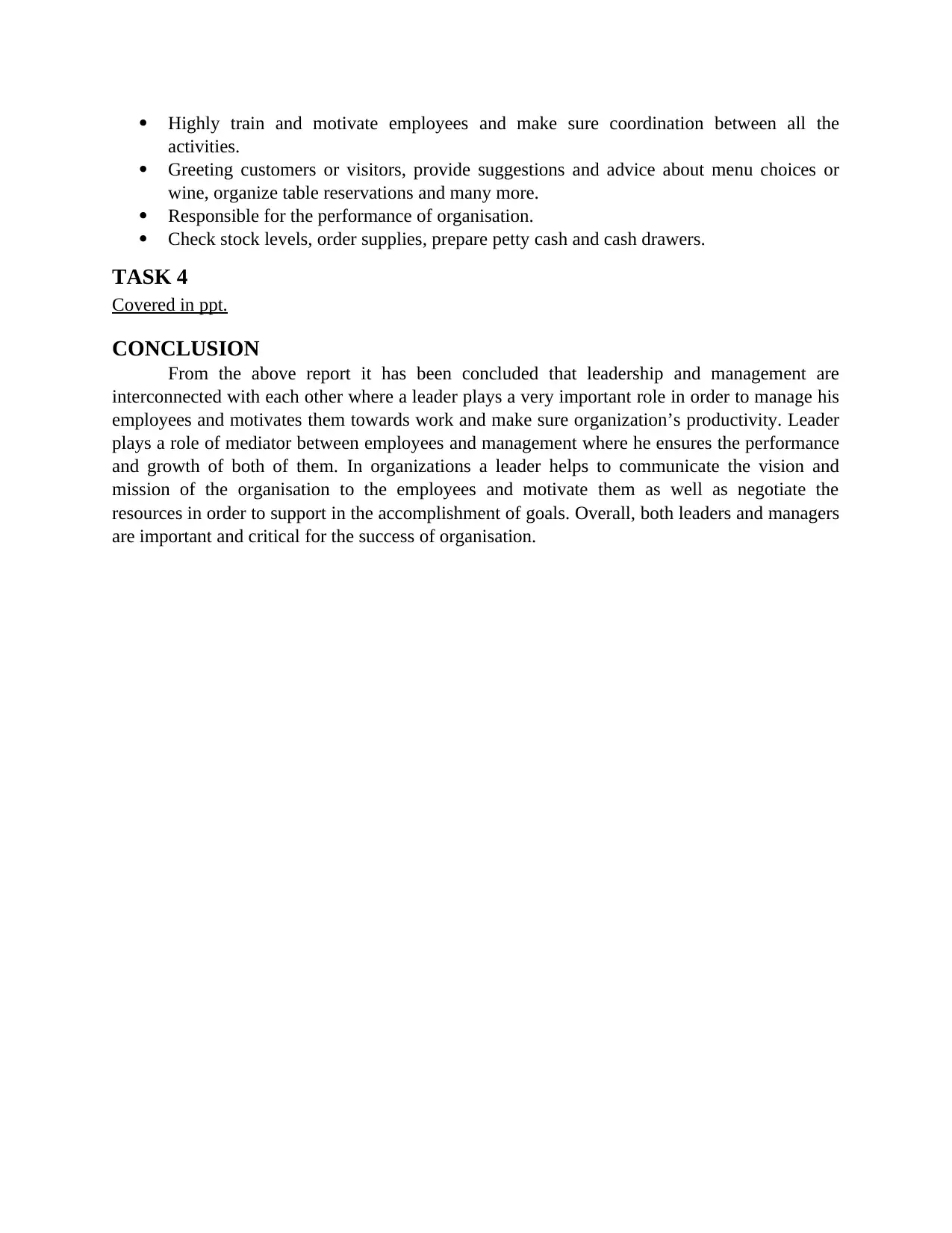
Highly train and motivate employees and make sure coordination between all the
activities.
Greeting customers or visitors, provide suggestions and advice about menu choices or
wine, organize table reservations and many more.
Responsible for the performance of organisation.
Check stock levels, order supplies, prepare petty cash and cash drawers.
TASK 4
Covered in ppt.
CONCLUSION
From the above report it has been concluded that leadership and management are
interconnected with each other where a leader plays a very important role in order to manage his
employees and motivates them towards work and make sure organization’s productivity. Leader
plays a role of mediator between employees and management where he ensures the performance
and growth of both of them. In organizations a leader helps to communicate the vision and
mission of the organisation to the employees and motivate them as well as negotiate the
resources in order to support in the accomplishment of goals. Overall, both leaders and managers
are important and critical for the success of organisation.
activities.
Greeting customers or visitors, provide suggestions and advice about menu choices or
wine, organize table reservations and many more.
Responsible for the performance of organisation.
Check stock levels, order supplies, prepare petty cash and cash drawers.
TASK 4
Covered in ppt.
CONCLUSION
From the above report it has been concluded that leadership and management are
interconnected with each other where a leader plays a very important role in order to manage his
employees and motivates them towards work and make sure organization’s productivity. Leader
plays a role of mediator between employees and management where he ensures the performance
and growth of both of them. In organizations a leader helps to communicate the vision and
mission of the organisation to the employees and motivate them as well as negotiate the
resources in order to support in the accomplishment of goals. Overall, both leaders and managers
are important and critical for the success of organisation.
⊘ This is a preview!⊘
Do you want full access?
Subscribe today to unlock all pages.

Trusted by 1+ million students worldwide
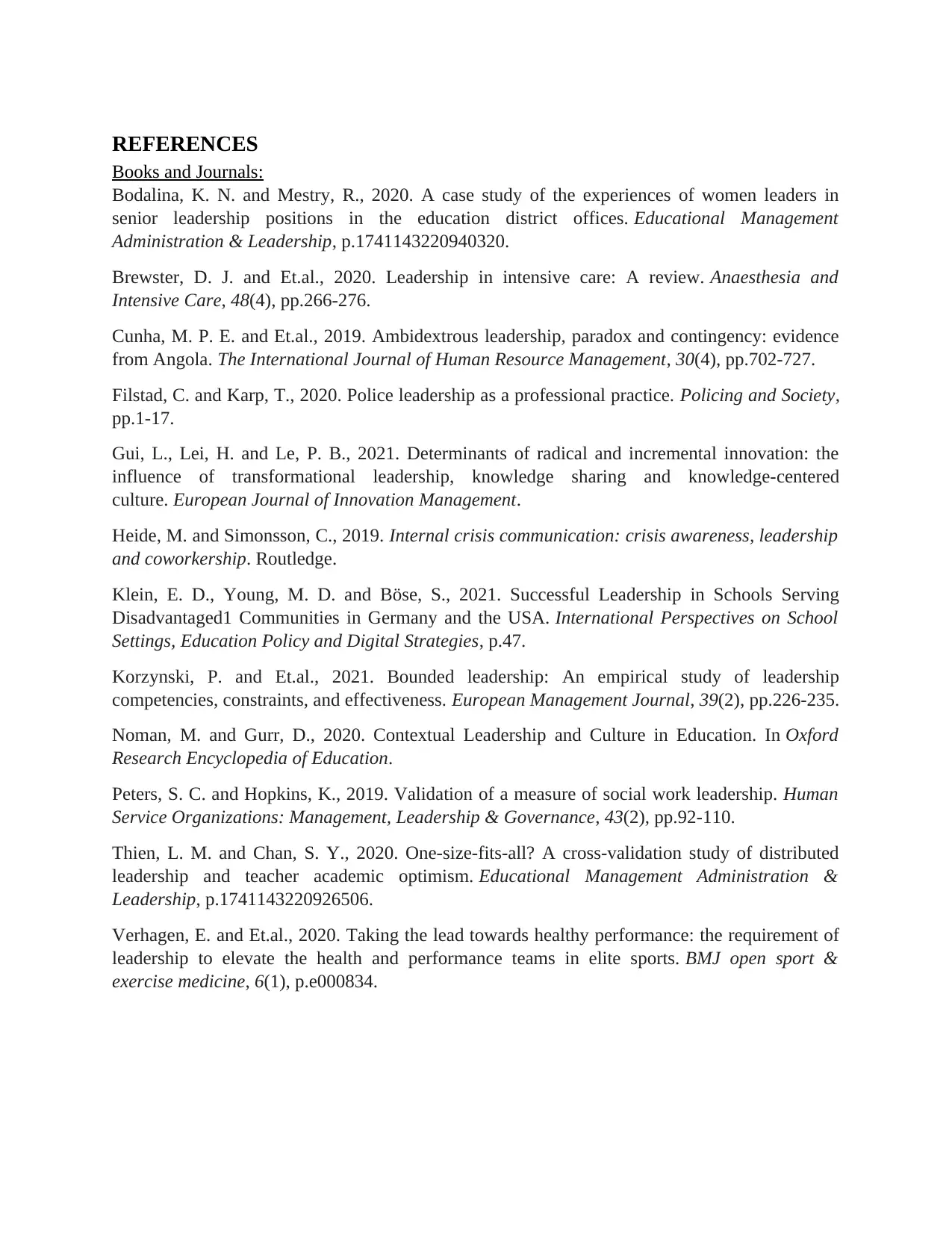
REFERENCES
Books and Journals:
Bodalina, K. N. and Mestry, R., 2020. A case study of the experiences of women leaders in
senior leadership positions in the education district offices. Educational Management
Administration & Leadership, p.1741143220940320.
Brewster, D. J. and Et.al., 2020. Leadership in intensive care: A review. Anaesthesia and
Intensive Care, 48(4), pp.266-276.
Cunha, M. P. E. and Et.al., 2019. Ambidextrous leadership, paradox and contingency: evidence
from Angola. The International Journal of Human Resource Management, 30(4), pp.702-727.
Filstad, C. and Karp, T., 2020. Police leadership as a professional practice. Policing and Society,
pp.1-17.
Gui, L., Lei, H. and Le, P. B., 2021. Determinants of radical and incremental innovation: the
influence of transformational leadership, knowledge sharing and knowledge-centered
culture. European Journal of Innovation Management.
Heide, M. and Simonsson, C., 2019. Internal crisis communication: crisis awareness, leadership
and coworkership. Routledge.
Klein, E. D., Young, M. D. and Böse, S., 2021. Successful Leadership in Schools Serving
Disadvantaged1 Communities in Germany and the USA. International Perspectives on School
Settings, Education Policy and Digital Strategies, p.47.
Korzynski, P. and Et.al., 2021. Bounded leadership: An empirical study of leadership
competencies, constraints, and effectiveness. European Management Journal, 39(2), pp.226-235.
Noman, M. and Gurr, D., 2020. Contextual Leadership and Culture in Education. In Oxford
Research Encyclopedia of Education.
Peters, S. C. and Hopkins, K., 2019. Validation of a measure of social work leadership. Human
Service Organizations: Management, Leadership & Governance, 43(2), pp.92-110.
Thien, L. M. and Chan, S. Y., 2020. One-size-fits-all? A cross-validation study of distributed
leadership and teacher academic optimism. Educational Management Administration &
Leadership, p.1741143220926506.
Verhagen, E. and Et.al., 2020. Taking the lead towards healthy performance: the requirement of
leadership to elevate the health and performance teams in elite sports. BMJ open sport &
exercise medicine, 6(1), p.e000834.
Books and Journals:
Bodalina, K. N. and Mestry, R., 2020. A case study of the experiences of women leaders in
senior leadership positions in the education district offices. Educational Management
Administration & Leadership, p.1741143220940320.
Brewster, D. J. and Et.al., 2020. Leadership in intensive care: A review. Anaesthesia and
Intensive Care, 48(4), pp.266-276.
Cunha, M. P. E. and Et.al., 2019. Ambidextrous leadership, paradox and contingency: evidence
from Angola. The International Journal of Human Resource Management, 30(4), pp.702-727.
Filstad, C. and Karp, T., 2020. Police leadership as a professional practice. Policing and Society,
pp.1-17.
Gui, L., Lei, H. and Le, P. B., 2021. Determinants of radical and incremental innovation: the
influence of transformational leadership, knowledge sharing and knowledge-centered
culture. European Journal of Innovation Management.
Heide, M. and Simonsson, C., 2019. Internal crisis communication: crisis awareness, leadership
and coworkership. Routledge.
Klein, E. D., Young, M. D. and Böse, S., 2021. Successful Leadership in Schools Serving
Disadvantaged1 Communities in Germany and the USA. International Perspectives on School
Settings, Education Policy and Digital Strategies, p.47.
Korzynski, P. and Et.al., 2021. Bounded leadership: An empirical study of leadership
competencies, constraints, and effectiveness. European Management Journal, 39(2), pp.226-235.
Noman, M. and Gurr, D., 2020. Contextual Leadership and Culture in Education. In Oxford
Research Encyclopedia of Education.
Peters, S. C. and Hopkins, K., 2019. Validation of a measure of social work leadership. Human
Service Organizations: Management, Leadership & Governance, 43(2), pp.92-110.
Thien, L. M. and Chan, S. Y., 2020. One-size-fits-all? A cross-validation study of distributed
leadership and teacher academic optimism. Educational Management Administration &
Leadership, p.1741143220926506.
Verhagen, E. and Et.al., 2020. Taking the lead towards healthy performance: the requirement of
leadership to elevate the health and performance teams in elite sports. BMJ open sport &
exercise medicine, 6(1), p.e000834.
1 out of 10
Related Documents
Your All-in-One AI-Powered Toolkit for Academic Success.
+13062052269
info@desklib.com
Available 24*7 on WhatsApp / Email
![[object Object]](/_next/static/media/star-bottom.7253800d.svg)
Unlock your academic potential
Copyright © 2020–2025 A2Z Services. All Rights Reserved. Developed and managed by ZUCOL.





